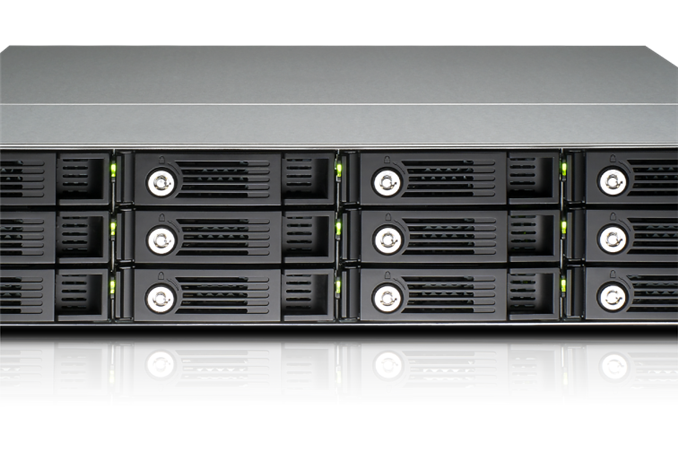QNAP Introduces Atom-based 12-bay TS-1269U-RP Rackmount NAS
by Ganesh T S on March 4, 2013 5:04 AM EST- Posted in
- NAS
- Storage
- IT Computing
- QNAP
- Enterprise

QNAP's flagship NAS lineup, the TS-ECx79U-RP, checks all the boxes for a high performance enterprise NAS in a rackmount form factor for high end SMBs. These include quad GbE ports (with a free PCIe slot to add a 10 GbE interface), a Xeon processor to handle the software RAID, volume encryption acceleration with AES-NI, dual redundant power supplies and so on. QNAP realized that there was a market demand for a cheaper version with the same form factor and a few similar features, but without the extreme performance provided by the Xeon-based platform. Towards this, QNAP recently introduced the TS-1269U-RP rackmount NAS for the SMB market.
The TS-1269U-RP provides 12 hot-swappable HDD bays in a 2U form factor and retains the dual redundant hot-swappable power supply feature from the flagship lineup. It is based on a dual-core Intel Atom D2700 series processor running at 2.13 GHz. The unit has 2 GB of DRAM which can be expanded by the user to 3 GB. Both 2.5" and 3.5" drives are supported and the unit comes with two GbE ports. Unlike the TS-ECx79U-RP flagship series, there are no PCIe slots available for expanding the network interface list. There are two USB 3.0, two eSATA and four USB 2.0 ports along with an HDMI output port. QNAP claims power consumption between 65 and 85W depending on the load on the NAS. With port trunking, QNAP was able to obtain up to 222 MB/sec read and 223 MB/sec write performance, well in line with what is obtained using other Atom-based NAS units with two trunked network links.
In terms of OS and software features, QNAP's embedded Linux firmware provides for secure cross platform file sharing, an iSCSI / IP-SAN storage combo and a number of other business applications.
It also integrates a number of backup applications. Virtualization support is also available, with the unit being Windows Server 2012 certified and also coming with VMware Ready and Citrix Ready certifications.
Surveillance Station Pro can also bring together various IP cameras for a video surveillance system. QNAP also provides the Qfile, Qmanager and Qmobile iOS / Android apps for accessing and monitoring the NAS on the go.
Source: QNAP










8 Comments
View All Comments
spazoid - Monday, March 4, 2013 - link
It's either a pleonasm, or you're saying that the unit has 4 power supplies.Either way, it's wrong. It either has redundant power supplies, or it has dual power supplies.
Anywho, it's a nice unit, but the price is probably going to be all wrong.
Robert Pankiw - Monday, March 4, 2013 - link
Listed at $2400, they certainly aren't giving them away.I think dual redundant makes sense. It is dual is the nunber of PSUs, redundant is desvribing theit setup. It could be dual non-redundant (2 PSUs, each with dedicated work load) or (in this case) dual redundant (2 PSUs, both sharing the same workload.)
Death666Angel - Monday, March 4, 2013 - link
You can have dual PSUs in non-redundant settings (one powering the system, another the HDDs, other systems have dual PSUs with one powering everything except the multi-GPUs and one just for the GPUs). And you can have non-dual redundant PSUs (3, 4, 5) so either of those statements alone would not describe this system accurately. Hence his use of dual redundant is perfectly fine and needed in order to convey the actual setup of the system.Juddog - Monday, March 4, 2013 - link
Since there is a free PCIE slot, I wonder if you could plug an infiniband adapter into this bad boy instead of a 10 GbE?ganeshts - Monday, March 4, 2013 - link
Hmm.. Not officially supported yet by QNAP, in its OS but I will ask :)shank15217 - Monday, March 4, 2013 - link
The Infiniband port will be as useless as a 10GbE port, the Atom doesnt' have the power to drive that type of high bandwidth card. Also you need RDMA protocols to take advantage of any of the cpu saving features.otherwise - Friday, March 15, 2013 - link
FreeNAS on a microserver can easily saturate a 1G line. You're obviously not going to get anywhere near 10G speeds without RDMA, but there is room for improvement.Gigaplex - Monday, March 4, 2013 - link
So many of these "higher end" NAS units go for Atom instead of ARM. I haven't seen a single one go for Bobcat from AMD. Why not?